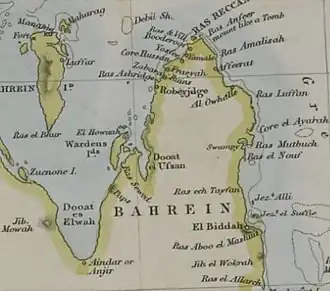Jabrids
Jabrids Emirate الإمارة الجبرية | |||||||||||||||
|---|---|---|---|---|---|---|---|---|---|---|---|---|---|---|---|
| 1417–1524 | |||||||||||||||
 Flag
 Coat of arms
| |||||||||||||||
 Realm of the Jabrids during Ajwad bin Zamil's reign | |||||||||||||||
| Common languages | |||||||||||||||
| Religion | Islam, Shia Twelver | ||||||||||||||
| Government | Emirate | ||||||||||||||
• 1417-1463 | Zamil bin Hussein bin Jabr (first) | ||||||||||||||
• 1500s-1524 | Ghossib bin Hilal (last) | ||||||||||||||
| Historical era | 15th-16th centuries | ||||||||||||||
• Established | 1417 | ||||||||||||||
• Disestablished | 1524 | ||||||||||||||
| |||||||||||||||
| History of Qatar |
|---|
 |
| History of Bahrain |
|---|
 |
|
|
| This article is part of a series on the |
| History of the United Arab Emirates |
|---|
 |
|
|
The Jabrids (Arabic: الجبريون, romanized: al-Jabrīyūn) or Banu Jabr were an Arab dynasty that ruled all of Arabia except for Hejaz, parts of Oman and Yemen, and expanded into Iran's southern coast, controlling the Strait of Hormuz.[1][2][3]
History
Their most prominent ruler was Ajwad ibn Zamil, who died in 1496. He was described by his contemporaries as having been "of tribe of Banu Uqayl origin." Ajwad's elder brother had earlier established the dynasty in the early 15th century by deposing and killing the last Jarwanid ruler in Qatif. At their height, the Jabrids controlled the entire Arabian coast on the Persian Gulf, including the islands of Bahrain, and regularly led expeditions into central Arabia and Oman.
The Jabrids had a major role in reviving the Ibadhi Imamate in opposition to the Nabhanids, as they supported the installation of Imam Omar Bin Khattab Al Kharusi in 1487 and Imam Muhammad bin Ismail in 1500.[4] However, Jabrid rule was limited in Oman as the interior was contested by the Jabrids in one part, the Imamate in another and the Nabhanids in another part, whilst most of the Omani coast overlooking the Gulf of Oman remained under the rule of Hormuz. Jabrid rule remained in effect in some regions till the arrival of the Portuguese.[5]
One contemporary scholar described Ajwad ibn Zamil as "the king of al-Ahsa and Qatif and the leader of the people of Najd." Following his death, his kingdom was divided among some of his descendants, with Migrin ibn Zamil (possibly his grandson) inheriting al-Hasa, Qatif, and Bahrain. Migrin fell in battle in Bahrain in a failed attempt to repel an invasion of Bahrain by the Portuguese in 1521.[6]
Culture and literature

The Jabrid state was widely recognized by historians for its strong support of Maliki law and traditional Islamic science. Sultan Ajwad ibn Zamil founded many schools across Eastern Arabia and Oman.[7] The Jabrids were also the first patrons of Nabati poetry written in Najdi Arabic[8][9]
See also
References
- ^ Al-Khalifa (2014-10-17). Bahrain Through The Ages. Routledge. ISBN 978-1-136-14650-3.
- ^ Al-Juhany, Uwidah Metaireek (2002). Najd Before the Salafi Reform Movement: Social, Political and Religious Conditions During the Three Centuries Preceding the Rise of the Saudi State. Ithaca Press. ISBN 978-0-86372-401-5.
- ^ السعدون (2012). ص 80
- ^ المحاضرة الثانية: امارة الجبور العقيلية Archived 2016-08-17 at the Wayback Machine
- ^ السعدون (2012). ص 80
- ^ Floor, Willem M.; Hakimzadeh, Farhad (2007). The Hispano-Portuguese Empire and Its Contacts with Safavid Persia, the Kingdom of Hormuz and Yarubid Oman from 1489 to 1720: A Bibliography of Printed Publications, 1508-2007. Peeters Publishers. ISBN 978-90-429-1952-5.
- ^ Watheeka (in Arabic). Markaz al-Wathāʾiq al-Tārīkhīyah bi-Dawlat al-Baḥrayn. 1985.
- ^ al-Shwēʿir, Ḥmēdān (2020-04-07). Arabian Satire: Poetry from 18th-Century Najd. NYU Press. ISBN 978-1-4798-4676-4.
- ^ Ẓāhir, al-Māyidī ibn (August 2023). ديوان واخبار المايدي بن ظاهر. NYU Press. ISBN 978-1-4798-2580-6.